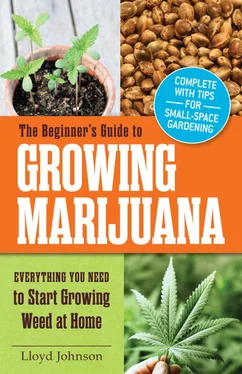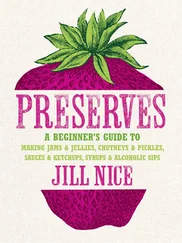Natural Soil
The growing medium is important. It serves as a source for water, air, and nutrients, and must also anchor the plant’s roots. Cannabis has high water and nutritive needs and grows very fast, unlike most houseplants. The indoor grow room is also an unnatural environment. Natural controls for harmful soil bacteria and insects must be replaced by the gardener’s attention and care.
The texture of the medium determines how well it holds water and how well it drains. Cannabis requires a well-drained medium for healthy growth. Soils that hold too much water can drown the roots, leading to poor growth, or may even kill the plants. Well-drained soil allows roots access to air as well as water. Soils that are dense clay, or too rich in compost that holds too much water, will not have enough air. Soilless media, like perlite, drains almost too well but contains no nutrients.
The soil must be nutrient-rich to satisfy the heavy feeding needs of cannabis. Some gardeners are adamant about using their own soil mixes because they have control over ingredients and amendments, but if you are just starting out, take advantage of a good quality premix. There are various kinds of bagged soils available at garden centers, but beware of cheap mixes. A cheap mix will be fluffy in texture and heavy on the perlite. Not that perlite is bad; in fact, it is very good for drainage, but it contains no nutrients at all. These mixes seldom contain enough nutrients to support healthy cannabis growth for long. Their nitrogen (N) is usually too low, phosphorus (P) level is adequate, and the potassium (K) level is usually very high.
It is far better to pay the higher price and use an organic bagged soil like FoxFarm Ocean Forest Potting Soil. A mix of the Ocean Forest quality has the correct texture for good drainage and is already preloaded with ideal nutrients for the vegetative phase cannabis plant. Black Gold makes an organic potting soil that is adequate, but for cannabis it needs adjustment with sandy loam; the texture is too fluffy; and, additionally, it contains less specialized organic nutrients than the more expensive mixes.
Keep It Simple
To simplify, you may want to start out using really good, bagged potting soil. The average size of a home indoor grow makes this a feasible expense most of the time.
Soilless Soil
Some indoor growers prefer to use a soilless medium and feed nutrients to their plants, or use a mix that includes real soil. These media can improve a natural soil that has poor drainage characteristics.
• Perlite is expanded sand or volcanic glass. It is almost weightless, contains no nutrients, and is near neutral in pH. Perlite mixed with real soil can hold water, air, and nutrients from the soil, and it is particularly good at aerating heavy soil.
• Vermiculture is also near neutral in pH. It, too, holds water, air, and nutrients well and will improve the texture of sandy or fast-draining soils. Jiffy Mix, Ortho Mix, or similar mixes are made of ground vermiculite and sphagnum moss and are fortified with a small amount of nutrients.
• Peat moss (also sometimes called sphagnum moss) is sometimes used by growers to improve water holding and texture. Used in excess, it tends to make the medium too acidic after a few months of watering. As a soil amendment, peat moss breaks down too fast, compressing the soil, and creating an unhealthy lack of air for plant roots. Environmentally conscious growers use alternative products.
Choosing the Best Strains
Modern indoor cannabis breeders have spent years modifying plant characteristics to optimize quality and adapt to the indoor methods of production. Cannabis competitions have created international arenas for breeders to compare accomplishments and to market their strains to the world.
Some strains remain classics and are available for years. Others are improved upon and become harder to find as growers continue to refine flavor, aroma, and effects. Cannabis strain development and the ability to procure different recreational strains rise and fall with the fads and fashions, sometimes driven by clever marketing and publicity.
The best seed sites will list their strains like a good garden catalog. They list provenance, typical characteristics of the strain in appearance, preferred growing conditions, and the qualities of the end product, usually both for productivity and effects. This is very useful if you have limited space and need reliable information about results you can expect from your grow.
Some well-known strains that are known to grow easily and well for indoor growers include the following:
• Silver Haze is a tall plant for indoors, due to a mainly sativa background. Silver Haze is a cross of a sativa, Purple Haze, to a nondominant indica. The indoor breeder’s goal was to minimize height and flowering time of the typical sativa while still retaining the unique sativa psychoactive effect.
• Kush is a pure indica and is a short, compact plant. A two-time winner of the international Cannabis Cup, Kush is very popular among indica growers.
• New York Diesel is an Afghani/sativa hybrid. This strain is considered good for beginning growers because it is very disease resistant and tends to grow uniformly.
• Northern Lights is another short, compact plant with big broad leaves and large flowers. This strain is considered a classic and is easy to grow.
• Big Bud is also a classic and was the Cannabis Cup winner in 1989 as a best strain. The yield is legendary, producing massive flowers.
The Growing Cycle (Overview)
We go over the growing cycle in more detail in Chapter 8, but for now, remember that the beginning of the cycle is procuring clones or starting your seeds. These little ones will need to be nurtured until they are of big enough size to be transplanted to big containers. The word “clone” can actually be a little vague. A clone does not have to be the size of a cutting; this is just when growers generally receive them from the propagator. Sometimes a clone arrives as a three- or four-foot-tall plant, a happy bonus. You may also have to root some cuttings to get started. Plan on two to four weeks for the cuttings to root and become actual little plant clones. Once you have little plants, you want your grow room lights to cycle for the vegetative phase. Make sure the plants get eighteen-hour “days” and six-hour “nights” for two full weeks.
The first transplant for seedlings is usually from their little four-inch starter pots to a three- or five-gallon container. This will allow enough room for the plants to grow while they make their sexual determination. Clones are known females, so you can put them right into your largest container.
The plants will be in what is called the vegetative phase of growth. This is when plants grow roots, gain size, and build strong stems and lots of healthy green leaves. Cannabis is light sensitive and requires a light trigger to begin the phase of flower development so desired by cannabis growers. During the vegetative phase, the plants will need plenty of water and more nitrogen than during the flowering phase.
If you plan to make clones from this crop, now is the time to take cuttings. It is possible to clone from a flowering plant, but this is not advised. It takes the cutting far longer to root, and the new little plant may try to flower right away.
The plants will grow until the seventh week, when you should shorten the light cycle from eighteen-hour days and six-hour nights to twelve hours of each. This is the sign or trigger to the plants that the days remaining for reproduction are becoming fewer. The plants will begin flowering in an attempt to reproduce, which is their natural goal. Some growers report that giving the plants an initial thirty-six hours of darkness before starting the twelve/twelve light cycle will shorten the time it takes for flowering to appear.
Читать дальше












